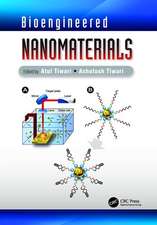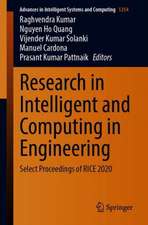Handbook of Deep Learning in Biomedical Engineering: Techniques and Applications
Editat de Valentina Emilia Balas, Brojo Kishore Mishra, Raghvendra Kumaren Limba Engleză Paperback – 16 noi 2020
- Presents a comprehensive handbook of the biomedical engineering applications of DL, including computational neuroscience, neuroimaging, time series data such as MRI, functional MRI, CT, EEG, MEG, and data fusion of biomedical imaging data from disparate sources, such as X-Ray/CT
- Helps readers understand key concepts in DL applications for biomedical engineering and health care, including manifold learning, classification, clustering, and regression in neuroimaging data analysis
- Provides readers with key DL development techniques such as creation of algorithms and application of DL through artificial neural networks and convolutional neural networks
- Includes coverage of key application areas of DL such as early diagnosis of specific diseases such as Alzheimer’s, ADHD, and ASD, and tumor prediction through MRI and translational multimodality imaging and biomedical applications such as detection, diagnostic analysis, quantitative measurements, and image guidance of ultrasonography
Preț: 808.69 lei
Preț vechi: 851.26 lei
-5% Nou
Puncte Express: 1213
Preț estimativ în valută:
154.76€ • 160.98$ • 127.77£
154.76€ • 160.98$ • 127.77£
Carte tipărită la comandă
Livrare economică 07-21 aprilie
Preluare comenzi: 021 569.72.76
Specificații
ISBN-13: 9780128230145
ISBN-10: 0128230142
Pagini: 320
Ilustrații: 140 illustrations (40 in full color)
Dimensiuni: 191 x 235 mm
Greutate: 0.55 kg
Editura: ELSEVIER SCIENCE
ISBN-10: 0128230142
Pagini: 320
Ilustrații: 140 illustrations (40 in full color)
Dimensiuni: 191 x 235 mm
Greutate: 0.55 kg
Editura: ELSEVIER SCIENCE
Cuprins
1. Application of deep learning in biomedical engineering
2. Applications, algorithms, tools directly related to deep learning
3. Computational Neuroscience; Neuroimaging and Time Series data (including MRI/fMRI/CT, EEG/MEG, etc.) studies;
4. Data Fusion for HealthCare, especially Biomedical images of different nature (X-ray, CT, etc.);
5. Deep neural network in medical image processing (RTG, USG, CT, PET, OCT and others)
6. Early diagnosis of specific diseases like Alzheimer, ADHD, ASD etc
7. Manifold learning, classification, clustering and regression in Neuroimaging data analysis;
8. Multimodal imaging techniques: data acquisition, reconstruction; 2D, 3D, 4D imaging, etc.)
9. Optimization by deep neural networks, Multi-dimensional deep learning
10. Prediction of tumor from MRI using deep learning
11. Theoretical understanding of deep learning in biomedical engineering
12. Translational multimodality imaging and biomedical applications (e.g., detection, diagnostic analysis, quantitative measurements, image guidance of ultrasonography)
2. Applications, algorithms, tools directly related to deep learning
3. Computational Neuroscience; Neuroimaging and Time Series data (including MRI/fMRI/CT, EEG/MEG, etc.) studies;
4. Data Fusion for HealthCare, especially Biomedical images of different nature (X-ray, CT, etc.);
5. Deep neural network in medical image processing (RTG, USG, CT, PET, OCT and others)
6. Early diagnosis of specific diseases like Alzheimer, ADHD, ASD etc
7. Manifold learning, classification, clustering and regression in Neuroimaging data analysis;
8. Multimodal imaging techniques: data acquisition, reconstruction; 2D, 3D, 4D imaging, etc.)
9. Optimization by deep neural networks, Multi-dimensional deep learning
10. Prediction of tumor from MRI using deep learning
11. Theoretical understanding of deep learning in biomedical engineering
12. Translational multimodality imaging and biomedical applications (e.g., detection, diagnostic analysis, quantitative measurements, image guidance of ultrasonography)





















